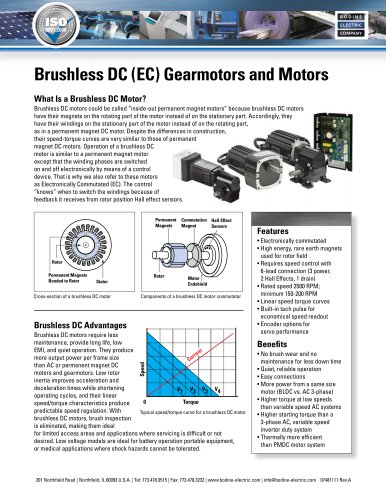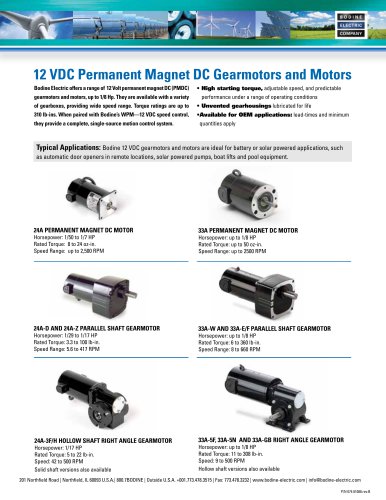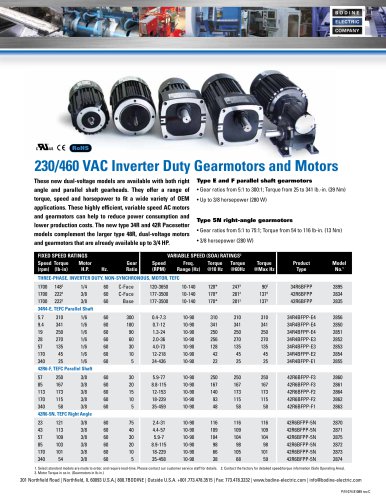 Website:
BODINE ELECTRIC COMPANY
Website:
BODINE ELECTRIC COMPANY
Catalog excerpts

Small Motors Gearmotors Motion Controls
Open the catalog to page 1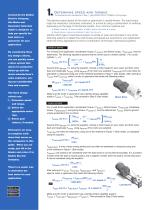
Created by the Bodine Electric Company, this Motor and Gearmotor Selection Guide is designed to help you specify the best motor or gearmotor for your application. By considering three key design criteria, you can quickly select a drive system that allows for productive follow-up with the motor manufacturer’s sales engineers, saving you considerable time and expense. The three design criteria are: 1 Determine speed and torque. [2| Select the appropriate motor type. 3 Select gear reducer, if needed. Enclosed is an easy-to-complete worksheet that serves as the companion to this guide. When you...
Open the catalog to page 2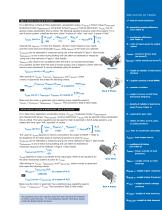
Definition of terms d = lead of screw (inch/rev) BELT DRIVE or RACK & PINION For a Belt Drive or Rack & Pinion application, acceleration torque, (TACCEL), friction torque,(TFRICTION), breakaway torque,(TBREAKAWAY), and gravity torque,(TGRAVITY) must be determined. TACCEL may be ignored unless acceleration time is critical. The following equations assume a belt drive system. For a rack & pinion system, substitute the word “pinion” in place of “roller”, and “rack” in place of “belt.” TACCEL (oz-in) = E= gearmotor gearing efficiency (see Table 3) e = mechanism efficiency (see Table 3) G =...
Open the catalog to page 3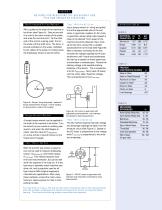
METHODS FOR MEASURING THE BREAKAWAY AND FRICTION TORQUE OF A MACHINE. The String and Pulley Method Affix a pulley to the shaft of the machine to be driven (see Figure A). Secure one end of a cord to the outer surface of the pulley and wrap the cord around it. Tie the other end of the cord to a spring scale. Pull on the scale until the shaft turns. The force, in pounds indicated on the scale, multiplied by the radius of the pulley (in inches) gives the breakaway torque in pound-inches. “Test” With An AC Drive Use a torque wrench or “string and pulley” to find the approximate size of the test...
Open the catalog to page 4
Select a motor type appropriate for the application By answering a few key questions, you can select a suitable motor type as a sample in your application. You can then discuss the application in detail with the motor manufacturer’s sales engineers. Actual testing of the sample will confirm your selection. yes Does application require an adjustable output speed? no What type of power supply is available? no Does application require an output speed >3600 RPM? no Will motor be powered in continuous stall? Does application require an adjustable output speed? Does application require controlled...
Open the catalog to page 5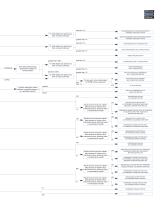
BODINE ELECTRIC COMPANY SYNCHRONOUS POLYPHASE MOTOR WITH VARIABLE FREQUENCY DRIVE To what degree can speed vary from no load to full load? NON-SYNCHRONOUS POLYPHASE MOTOR WITH VARIABLE FREQUENCY DRIVE greater than 1% less than 1% SYNCHRONOUS POLYPHASE MOTOR To what degree can speed vary from no load to full load? NON-SYNCHRONOUS POLYPHASE MOTOR SERIES WOUND MOTOR How does starting torque requirement compare to running torque? SYNCHRONOUS SPLIT PHASE MOTOR NON-SYNCHRONOUS SPLIT PHASE MOTOR greater than 1% less than 150% To what degree can speed vary from no load to full load? Is motor...
Open the catalog to page 6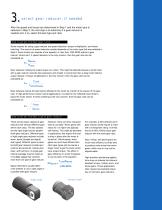
select gear reducer, if needed After the speed and torque are determined in Step 1 and the motor type is selected in Step 2, the next step is to determine if a gear reducer is needed and, if so, select the best type and ratio. How to select the best gear ratio Some reasons for using a gear reducer are speed reduction, torque multiplication, and inertia matching. The amount of speed reduction needed depends on the motor type that was selected in Step 2. Some motors can operate at low speeds (i.e. less than 1000 RPM) without a gear reducer; others can’t. If speed reduction is the only...
Open the catalog to page 7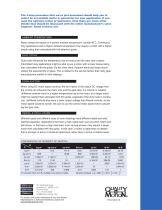
The 3-step procedure that we’ve just presented should help you to select an acceptable motor or gearmotor for your application. If you want the optimum motor or gearmotor, then there are many other details that should be discussed with the motor manufacturer’s sales engineer. Some of these are: ambient temperature Motor ratings are based on a certain ambient temperature, usually 40°C. Continuous duty applications with a higher ambient temperature may require a motor with a higher torque rating than calculated with this selection guide. duty cycle Duty cycle influences the temperature rise...
Open the catalog to page 8All BODINE ELECTRIC COMPANY catalogs and technical brochures
-
2998
2 Pages
-
34B-WX , 33A-WX
2 Pages
-
33A7-WX
2 Pages
-
42R-5L/H
2 Pages
-
IP-66
2 Pages
-
IP-69K
2 Pages
-
STANDARD PRODUCTS 2024
52 Pages
-
PLANETARY BLDC GEARMOTORS
2 Pages
-
Bodine Electric Handbook
252 Pages
-
42R-FX AC Gearmotor
2 Pages


